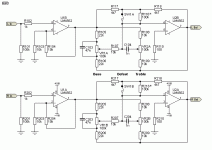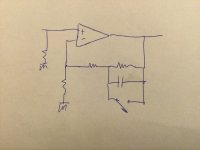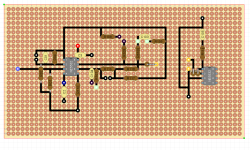I`m playing with it at the moment. Yes it can play clean & loud, but with bass boost all the way down...
There is just too much boost, even my bookshelf speakers can`t handle it with some music...
Music was just different back then, when this radio was made, so this went, but nowadays no...
So even if I make enclosure, bellow 100hz wont go?
There is just too much boost, even my bookshelf speakers can`t handle it with some music...
Music was just different back then, when this radio was made, so this went, but nowadays no...
So even if I make enclosure, bellow 100hz wont go?
That digital filter looks like about a 4th order slope. Around 50 Hz is probably about right. A single time constant filter would be much shallower.
To remove the “excess” boost, remove the 47 nF that’s in series with the 1k. That by itself may upset the turnover frequencies of the existing tone controls, you’d have to run it through a simulator to be sure. (For linear circuits, a simulator is just a fast way to do 5 pages of algebra, and gives the same result. One can calculate the response by hand.) To sort of meet it half way, split the resistor, putting 2K in series and 2K in parallel with the cap.
As far as response below 100, hell, even 200 or 300 - that’s what all the excess boost is supposed to fight. As you can see it DOES have its limitations. You want to retain the type of “tone” you are looking for? Find an old light stiff cone 8 or 10” full range (preferably with a whizzer, and a high Qts value), or a similar vintage 6x9. The kind used in vintage consoles and floor standing radios. Then you an get by with a modest 6 dB low end boost and still have it sound “natural”. Modern “full ranges” don’t have the right sound at all.
To remove the “excess” boost, remove the 47 nF that’s in series with the 1k. That by itself may upset the turnover frequencies of the existing tone controls, you’d have to run it through a simulator to be sure. (For linear circuits, a simulator is just a fast way to do 5 pages of algebra, and gives the same result. One can calculate the response by hand.) To sort of meet it half way, split the resistor, putting 2K in series and 2K in parallel with the cap.
As far as response below 100, hell, even 200 or 300 - that’s what all the excess boost is supposed to fight. As you can see it DOES have its limitations. You want to retain the type of “tone” you are looking for? Find an old light stiff cone 8 or 10” full range (preferably with a whizzer, and a high Qts value), or a similar vintage 6x9. The kind used in vintage consoles and floor standing radios. Then you an get by with a modest 6 dB low end boost and still have it sound “natural”. Modern “full ranges” don’t have the right sound at all.
I must do some thinking, before the next step. We did the preamp & amp to my wishes, just to use the stock speaker and keep the sound... Now I see that this wont go. And it really does a good job, I was really pleased with it... But modern music just wont go.
Your idea seems really good to me, but I can`t get 8 or 10". Internal height dimension in radio is 12.5cm (4.9 inch)... So I would need oval speaker, even 6x9 wont go :/. 5x8 would go with slight modification, but I can only find car speakers.
I was also thinking of changing +-8v regulators to +-12v, then I would get about 10w (or even use unregulated, full +-16v), modify preamp feedback loop & install a new speaker in a box. I could make a 4 liter box in there (internal dimensions taken into account). I have original Sony 3" fullrange in 3 liter ported box and it plays good. So 4 liter ported box definately has some potential.
I will also look at what I can get in the style of what you described, also more powerfull, to make it easier on the bass.
Your idea seems really good to me, but I can`t get 8 or 10". Internal height dimension in radio is 12.5cm (4.9 inch)... So I would need oval speaker, even 6x9 wont go :/. 5x8 would go with slight modification, but I can only find car speakers.
I was also thinking of changing +-8v regulators to +-12v, then I would get about 10w (or even use unregulated, full +-16v), modify preamp feedback loop & install a new speaker in a box. I could make a 4 liter box in there (internal dimensions taken into account). I have original Sony 3" fullrange in 3 liter ported box and it plays good. So 4 liter ported box definately has some potential.
I will also look at what I can get in the style of what you described, also more powerfull, to make it easier on the bass.
Last edited:
5x7 car speaker would fit... It is a good thing that it is also designed for use in semi-closed space, but I don`t know what to expect from the sound... It would be more accurate and clear, thats for sure...,
Something like this maybee: click
"Tuning" ones all have crazy high wattage ratings and plastic cones.
Something like this maybee: click
"Tuning" ones all have crazy high wattage ratings and plastic cones.
Last edited:
Try holding it in all possible orientations, sometimes the rattling goes away when the cone/coil weigth pulls the voice coil in the "correct" position.Yeah, it`s the speaker, I can hear rattling coming out of it when bass boosted. Nothing seems loose, but will triple check carefuly.
I have a solution, it's sitting next to me 🙂
Sound wont stay original as it was intended, but it sounds awsome with tone controls, much better than it did with stock component. It's the sound I would listen to every day.
It's a 4ohm rated 30w, 3" full range speaker from Sony, circa 2007.
Ported enclosure takes care of low end lovely.
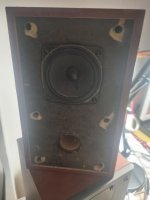
It will not fit in the radio as is, but it's volume does fit.
So it will be a small woodworking project.
It's not the same sound, but on the other hand it's clear and punchy. Replacements easily avaliable second hand and it will last for a long time.
80s music sounds bassy, 90s punchy... just like it needs to be.
Now I need to make tone controls much more subtile...
Also I will change regulators either to 12v +-, or unregulated 16.
Sound wont stay original as it was intended, but it sounds awsome with tone controls, much better than it did with stock component. It's the sound I would listen to every day.
It's a 4ohm rated 30w, 3" full range speaker from Sony, circa 2007.
Ported enclosure takes care of low end lovely.

It will not fit in the radio as is, but it's volume does fit.
So it will be a small woodworking project.
It's not the same sound, but on the other hand it's clear and punchy. Replacements easily avaliable second hand and it will last for a long time.
80s music sounds bassy, 90s punchy... just like it needs to be.
Now I need to make tone controls much more subtile...
Also I will change regulators either to 12v +-, or unregulated 16.
More gradual tone control would be a standard Baxandall type control. They also use an inverting op amp, but take linear pots. I might also add a switchable shelving boost of 6 dB at about 600 Hz, which compensates half space (at high frequency) vs. free space (low frequency) radiation. Also known as “baffle step compensation”. Another reason small speakers sound small - when this isn’t taken into account.
As for original speaker, now I have two to spare.
I also have single ended EL84 amp, that I had build a while ago.
I will buy the same old cheap records player that I did scrap the tube and output transformer from and rebuild stereo version of it & add tone controls.
I know that it wont be a matched pair, but they are NOS EL84 tubes by Ei Niš.
For cabinets, I will build something like that:
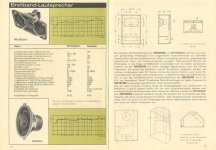
It`s for an Isophon speakers, but they do look suspicious similar:

But that comes after I finish this radio.
I also have single ended EL84 amp, that I had build a while ago.
I will buy the same old cheap records player that I did scrap the tube and output transformer from and rebuild stereo version of it & add tone controls.
I know that it wont be a matched pair, but they are NOS EL84 tubes by Ei Niš.
For cabinets, I will build something like that:

It`s for an Isophon speakers, but they do look suspicious similar:

But that comes after I finish this radio.
Last edited:
The top diagram in 292 is a standard Baxandall tone control. To add the shelving boost, the first stage is converted to something like this. The cap value you want depends on the size of the box. You don’t want it to boost only the bass, since the fall off that you fight happens right in the middle of the lower midrange, making vocals and musical fundamentals sound thin. What I do about it is put the crossover frequency between a woofer and midrange right in the middle of the transition, and use a 3 to 6 dB LESS sensitive midrange. The bigger the box, the lower the crossover frequency is used. This does NOT work well with the typical 2 to 4 kHz crossover used in a 2 way since the action needs to happen at a lower frequency. Works perfect on single driver full ranges. It can be done with a parallel RL at speaker level, but it’s really best to do it in the preamp if you have the means, and especially if the system has no pretense of being “hi-fi” and is just being tuned to “sound good”.
Attachments
Nice, I had bought parts for it and 12v regs to lift the rails for the amp.
I'm currently at work right now, working 2nd shift this week.
Will measure the box precisely when I get home, it's about 3 litre, ported.
I guess porting also should be taken into account with shelving boost?
I can also measure the port and try to find out resonant frequency visualy (where Xmax is the biggest), but T/S is probably out of reach for this driver.
I'm currently at work right now, working 2nd shift this week.
Will measure the box precisely when I get home, it's about 3 litre, ported.
I guess porting also should be taken into account with shelving boost?
I can also measure the port and try to find out resonant frequency visualy (where Xmax is the biggest), but T/S is probably out of reach for this driver.
Baffle step frequency does not really depend on being ported or sealed. But ported can often result in a bass boost that lifts enough of the low midrange to require a little less compensation (ie, not the full 6 dB). When speakers are large enough, you also get a little gain just from the woofer being in proximity to the floor. But this is a little bitty thing that sits on a table somewhere. Even if it’s a little too much I’d put in the 6 dB - one can always back off on the bass control a bit if need be. Hell, most of the time people want a little bass boost when just casually listening.
The resonant frequency of a ported box is just the opposite - at the port resonant frequency cone movement is at a local minimum. This of course assumes the box is tuned properly - but one cannot always make that assumption. Even from something store bought.
The resonant frequency of a ported box is just the opposite - at the port resonant frequency cone movement is at a local minimum. This of course assumes the box is tuned properly - but one cannot always make that assumption. Even from something store bought.
Ok, thank you for explanation. I gave my try to the "flat response world" audiophile and from that I had learned that I do want a little bass boost.
My bad on resonant frequency, it's been a while since I was in subwoofers.
Will check box volume in a few hours, when I get home.
My bad on resonant frequency, it's been a while since I was in subwoofers.
Will check box volume in a few hours, when I get home.
- Home
- Amplifiers
- Solid State
- Amplifier suggestion for old 3w speaker
